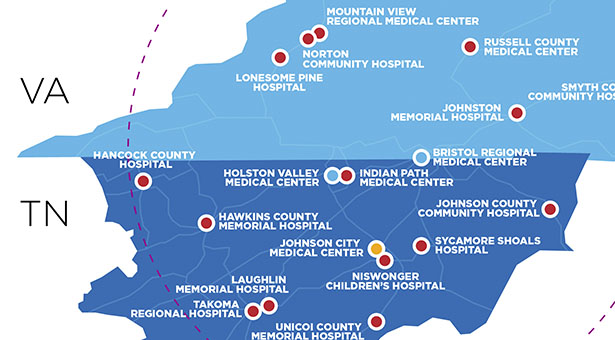By Scott Robertson
The Ballad Health board unanimously approved plans to create a trauma and emergency care system designed to improve the overall access to services system-wide through realignment of resources. Concurrently, Ballad will offer a new range of pediatric services at Johnson City Medical Center, Holston Valley Medical Center and Bristol Regional Medical Center.
Alan Levine, Ballad Health executive chairman and CEO, briefed reporters for just under two hours Tuesday morning on the system’s plans regarding trauma, pediatric services, and particularly the realignment of services in Kingsport in order to better align with the rest of the region. “Right now, we have three trauma centers, but we have no trauma system.”
Levine assured those in attendance that the changes would endeavor to first, do no harm. “More than 65 percent of specialty consults for trauma are orthopedic and 20 percent are neurosurgery,” he said. “Those services will continue at all three trauma centers. The majority of trauma cases will be treated in the center closest to patient.”

Alan Levine
Levine, who prefaced his remarks by saying Ballad has already invested $4 million in new spending at Holston Valley this year, said the Level I designation at Holston Valley is based on the hospital accruing certain expenses it simply doesn’t make sense to accrue, especially when those dollars could be used more productively to provide services for which there is higher demand.
For instance, the hospital currently hires out-of-market specialists on a temporary basis at significant expense just to maintain the Level I designation. In reality, Levine said, the demand for those specialists’ services is so low, local doctors could handle the demand on an on-call basis while saving the hospital dollars it could use elsewhere. “You can be a Level III and provide the same physician services of a Level I.”
Johnson City Medical Center will retain its Level I designation moving forward and will pursue verification by the American College of Surgeons. Bristol Regional Medical Center will retain its current Level III Trauma Center designation.
The change in designation is only one part of the overall initiative to improve the access to trauma care and improve outcomes, Levine said.
At the heart of the trauma system will be a new coordination plan between Ballad and the region’s emergency medical services providers. Working through a planned new medical call center, Ballad hopes to create a regionwide set of protocols which will allow first responders to take patients directly to the facility they need to go to for trauma care. Said Levine, “When we implement this system, rural areas here will have better access to trauma care than most of America.”
Ballad hopes to work with EMS providers throughout Northeast Tennessee and Southwest Virginia to create regional pre-hospital trauma protocols to, as Levine said, “get patients to the right place – in the first place – as quickly as possible.”
 Using those protocols, an ambulance in Hawkins County might take a patient to a facility in Washington County for treatment, and in that case, Ballad could coordinate having another unit cover Hawkins County for the duration of the call. Currently, trauma patients are taken to the closest smaller hospital to be stabilized, then moved to a trauma center in Johnson City, Kingsport or Bristol. Ballad operates 16 hospitals that have emergency departments but are not designated as trauma centers.
Using those protocols, an ambulance in Hawkins County might take a patient to a facility in Washington County for treatment, and in that case, Ballad could coordinate having another unit cover Hawkins County for the duration of the call. Currently, trauma patients are taken to the closest smaller hospital to be stabilized, then moved to a trauma center in Johnson City, Kingsport or Bristol. Ballad operates 16 hospitals that have emergency departments but are not designated as trauma centers.
“Ballad is prepared to engage with EMS folks for the first time,” Levine said, adding, “We have to figure out upstream of the hospitals – county lines and city boundaries cannot be the limiting factor.”
Levine was quick to point out the difference between trauma and emergency care. “All our hospitals will continue doing what they’ve been doing for emergency care…If you’re having a heart attack, you’ll go to the nearest emergency room.”
Levine said Ballad would seek to add a research component to trauma center services. Of the 5,200 trauma cases Ballad facilities handled last year, more than 2,000 were geriatric falls. “We’d like to do research on contributing factors to falls and hopefully reduce the incidence of preventable trauma.”
Johnson City Medical Center, Holston Valley Medical Center and Bristol Regional Medical Center will all upgrade their pediatric offerings significantly over the same 10-month timeframe during which the trauma system will be implemented. Johnson City, in partnership with the Niswonger Children’s Hospital, will begin offering the region’s first pediatric trauma services, including a perinatal center and new pediatric specialties. Holston Valley and Bristol Regional will be home to new Niswonger Children’s Hospital-branded pediatric emergency rooms.
Last year, Levine said, there were around 20,000 visits to Sullivan County emergency rooms by children. “Those patients will have the benefit of a pediatric emergency room,” he said.
When asked about individuals in Kingsport who might feel the system is lowering the quality of their health care by moving Holston Valley from a Level I to a Level III trauma center, Levine pointed out that of the 5,200 trauma cases in Ballad’s footprint last year, fewer than 400 were considered “major trauma” and 60 percent of those were handled at Johnson City. Putting the costs of maintaining Level I status against what may be accomplished by the pediatric initiatives is an easy choice, he said. “Four hundred people versus thousands of children who currently don’t have access to a pediatric emergency department – if people see that as a loss, then I don’t know what to say to them.”
The trauma and pediatric initiatives will not result in job losses, Levine said, adding a promise to invest savings back into the provision of care rather than putting them toward the bottom line. “The priority here is to make health care more accessible, improve outcomes and save lives.”




